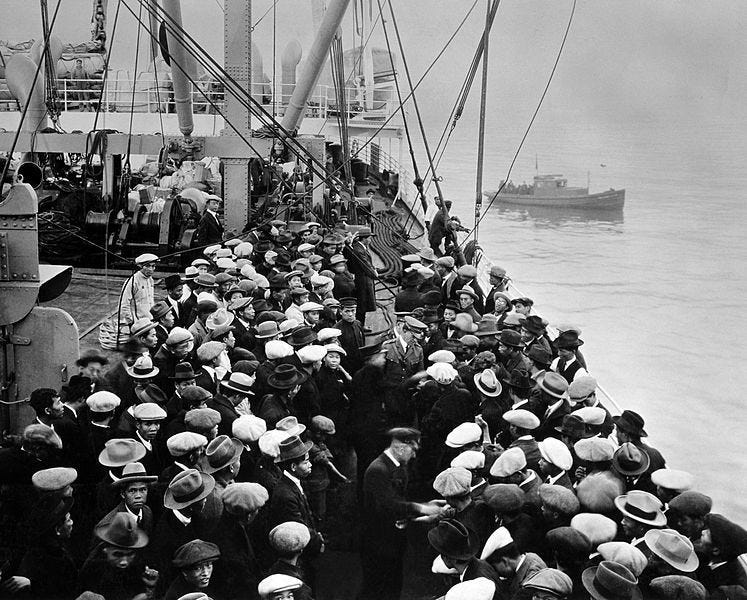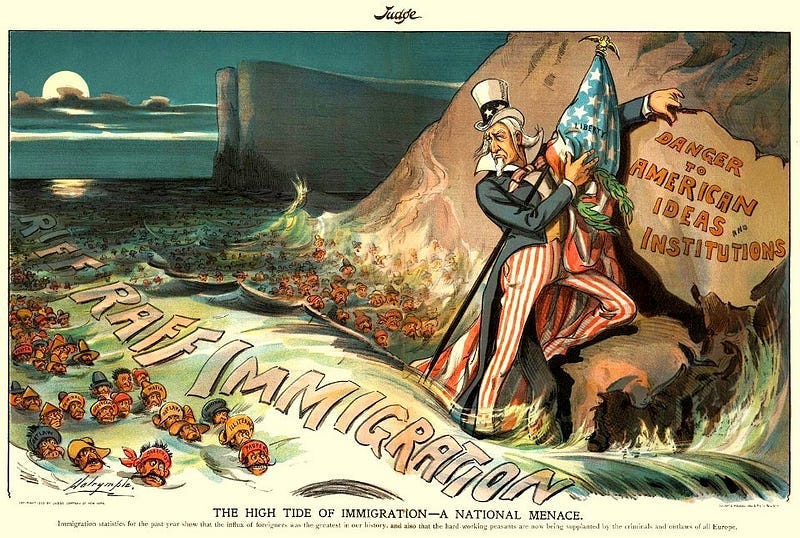Old Fears New Foes (1/5): New Reasons to Worry About Immigration
Scientists provided biological arguments to justify rejecting certain immigrants.
Scientists provided biological arguments to justify rejecting certain immigrants

During the 1920s, Americans became increasingly concerned about the biological quality of prospective immigrants resulting in the most restrictive Immigration Act ever enacted (Bruinis, 2006). Earlier concerns about immigrants and immigration were economic in nature and the focus on biological worth demands an explanation.
During this time, scientists preferred to debate within their fields of expertise and thus exert their authority. The scientific community claimed that they could address concerns even if these were, in reality, beyond their scope. Politicians used these claims to pursue immigration restrictions as a means to protect the nation. Concerned citizens and politicians latched onto the language and ideas of the eugenicists as these legitimised pre-existing anxieties regarding certain kinds of new immigrants. We believe that these anxieties, and not novel ones concerning biological quality, best explain why Americans chose to heavily restrict immigration*.
In this series we will explore each of these anxieties in different articles.
First, there was widespread skepticism about the assimilation of new immigrants, partly because many of them arrived intending to return to their home countries.
Second, new immigrants were perceived as inferior because they took low paying jobs which many Americans were either uninterested or unwilling to do.
Third, new immigrants were perceived as a threat because they were linked to crime and perversion.
Lastly, questions about race played a prominent role in discussions relating to new immigrants. Many of these fears were not new and had been previously directed towards other groups.
What was new was the legitimacy that scientists and eugenicists provided. Thus, Americans were able to justify the same old fears and find new foes. Among the latter, were Italians. Previous immigration restrictions were mostly based on economic concerns and have an interesting history of their own.
How were new immigrants perceived to be different?
Unlike those who had come before, new immigrants were “no longer of the same character” (Mayo-Smith, 1888). Initially, only the “energetic and intelligent” could migrate, but technological advances made migration cheaper and more manageable, and thus anyone could travel (Mayo-Smith, 1888). A 1907 study funded by the American Congress found “stark differences” between them and previous immigrants (Vellon, 2018).
Charles Davenport (1911), a prominent biologist, remarked that there were “great differences” between these new immigrants and those that came before. He claimed that the first migrants were “restless and ambitious” and consisted of “men of courage, independence, and love of liberty” (Davenport, 1911). Henry Laughlin, another prominent biologist, argued that at first immigrants were of “high moral qualities, high intelligence, honesty, altruism, democracy, a sense of fair play, and other traits which we value in the American character” (1924). For Laughlin, immigrants had originally been motivated by “Energy, initiative, love of liberty, and fine spiritual quality” ; however, these “were no longer the principal springs to emigration” (1924). Future president Woodrow Wilson described them as belonging to the “lowest class” (Spiro, 2009). They were “less Protestant, less educated, more impoverished, and more culturally alien” (Zenderland, 2001).

The change in the composition of immigrants, according to Madison Grant, meant that
Americans would “become darker in pigmentation, smaller in stature, more mercurial, more attached to music and art, more given to crimes of larceny, kidnapping, assault, murder, rape, and sex-immorality” (Spiro, 2009).
By 1924 the belief that these immigrants were “undesirable” was widely shared (Marinari, 2017).
Nevertheless, what is at stake is whether their biology or their culture made them undesirable.
Assimilating New Immigrants
Americans grew more anxious not only because new immigrants were different, but because there were more of them. Unlike the earlier immigrants who despite “differing in language, customs, and national characteristics” were “wielded into a homogeneous people,” some immigrants could not be assimilated (George, 1869). This “massive influx” of Russians, Hungarians, Poles, Greeks, and Italians raised concerns (Paul, 1995). New immigrants made up a larger portion of immigrants than ever before (Mayo-Smith, 1888). Italians, for example, chose to migrate after an epidemic and economic collapse worsened life in Italy (Okrent, 2019; LaGumina, 1973).
The rapid increase in the proportion of immigrants to native-born Americans fueled anxiety among the latter. By 1920 immigrants and their children made up about a third of the population (Paul, 1995). In 1907 famed author Henry James travelled to Boston and was indignant that in some areas he heard “no sound of English” (Okrent, 2019). For many, like Walker, an economist, new immigrants “posed a social, political, and above all, economic threat” (Spiro, 2009). Likewise, the New York Times expressed worries that America had become an asylum which would “wreck its present economic life and its future inheritance” (NYT, 1934).

New immigrants made Americans anxious because they spoke different languages, competed for jobs, worshipped differently, lived differently. It is important to note that none of these concerns are based on the biological quality of new immigrants.
The authority that scientists provided made passing immigration restriction easier, yet the legislation passed mainly because it legitimised underlying anxieties.
The language around the Johnson-Reed Act is misleading because of the legitimising role that scientists played. Scientists used scientific language to discuss immigration restrictions. Laughlin argued that “the principal consequences” of immigration “are biological or racial” (Laughlin, 1924). Thus immigration restriction was portrayed as a defence of future generations (Lombardo, 2008). The limits imposed by the 1924 Act were needed as a kind “of segregation on a large scale, by which inferior stocks can be prevented from both diluting and supplanting good stocks” (Hall, 1919). Efforts to restrict immigration preceded and coincided with scientific calls to ban certain kinds of immigrants. Immigration restriction became law once a welter of anxieties drove several stakeholders to agree. Members of this pro-restriction coalition were motivated by different factors.
The legitimacy that scientific authority provided allowed stakeholders who had previously found each other unpalatable to become strange bedfellows. The Johnson-Reed Act of 1924 passed as scientists gave scientific legitimacy to pre-existing anxieties regarding immigrants. The role of ideas about immigrants’ biological quality only seems pivotal because it coincided with stakeholders changing their minds.
Authors: Christian Orlic & Lucas Heili
This article is based on a paper written by Christian Orlic for one of his graduate degrees. We have divided this study into six articles.
Acknowledgements
The authors would like to express their gratitude to Lillian Manansala. Lillian orgsanised a few meetinhgs via Zoom for the colleages in this class to discuss ideas, arguments, and approaches to our research. Lillian also offered some proofreading. We also wanted to thank Eric Revis who provided comments of a general nature. Lastly Scott Thompson provided copy editing of the paper.
Sources (see the Fears-Foes Sources article).
*Our argument borrows explanatory frameworks from two books by Mark Largent. In seeking to explain the history of coerced sterilisation, Largent claimed that coerced sterilisation found widespread acceptance because scientists “provided scientific authority to support the prejudices that had motivated earlier advocates” (Largent, 2011, p2). Likewise, many of the same people who advocated for sterilisation provided the professional authority that made it possible to restrict immigration. Secondly, Largent’s framework explains modern vaccine denialism in a similar vein: namely, that anxious parents adopted concerns about an alleged link between vaccination and autism in order to legitimise preexisting anxieties (Largent, 2012). We believe that politicians and ordinary Americans adopted eugenicists’ ideas to justify pre-existing anxieties about new immigrants. Thus, our argument recognises the role played by prominent scientists who provided justifications for anxieties. Nevertheless, these scientists did not create these concerns.




